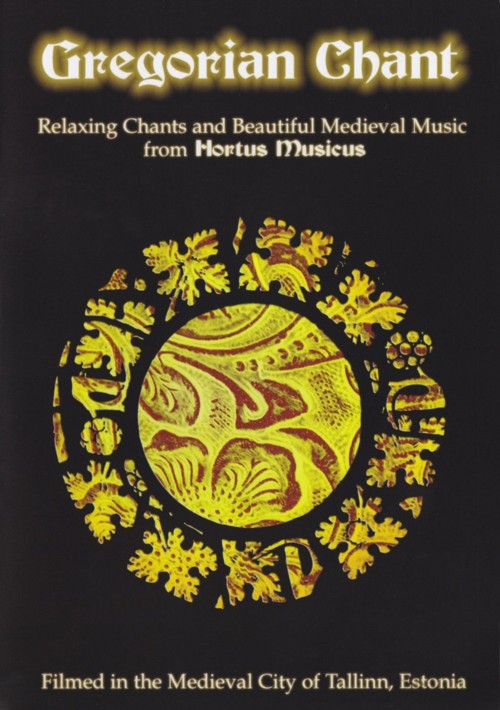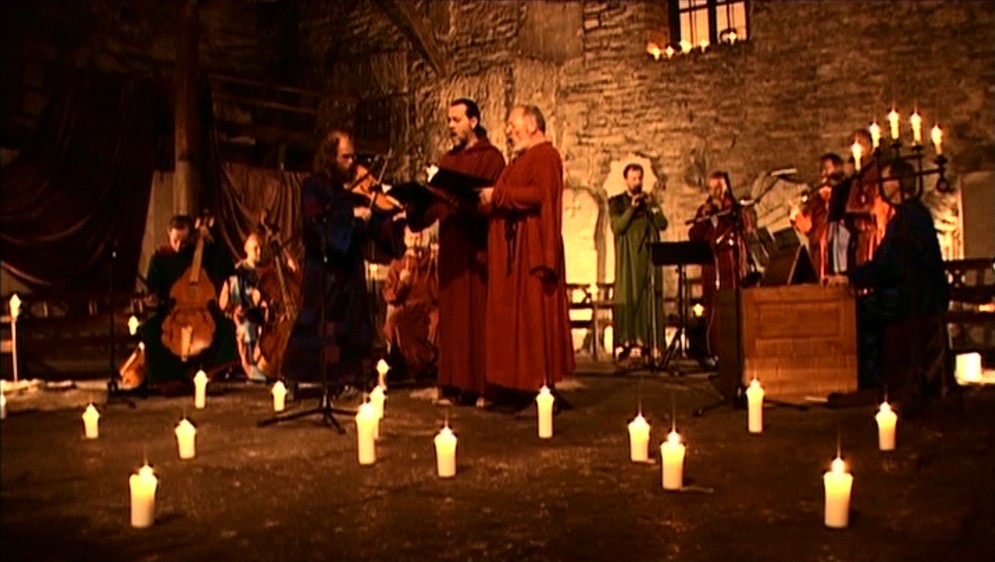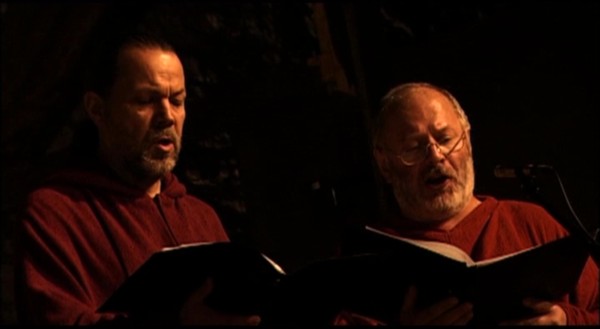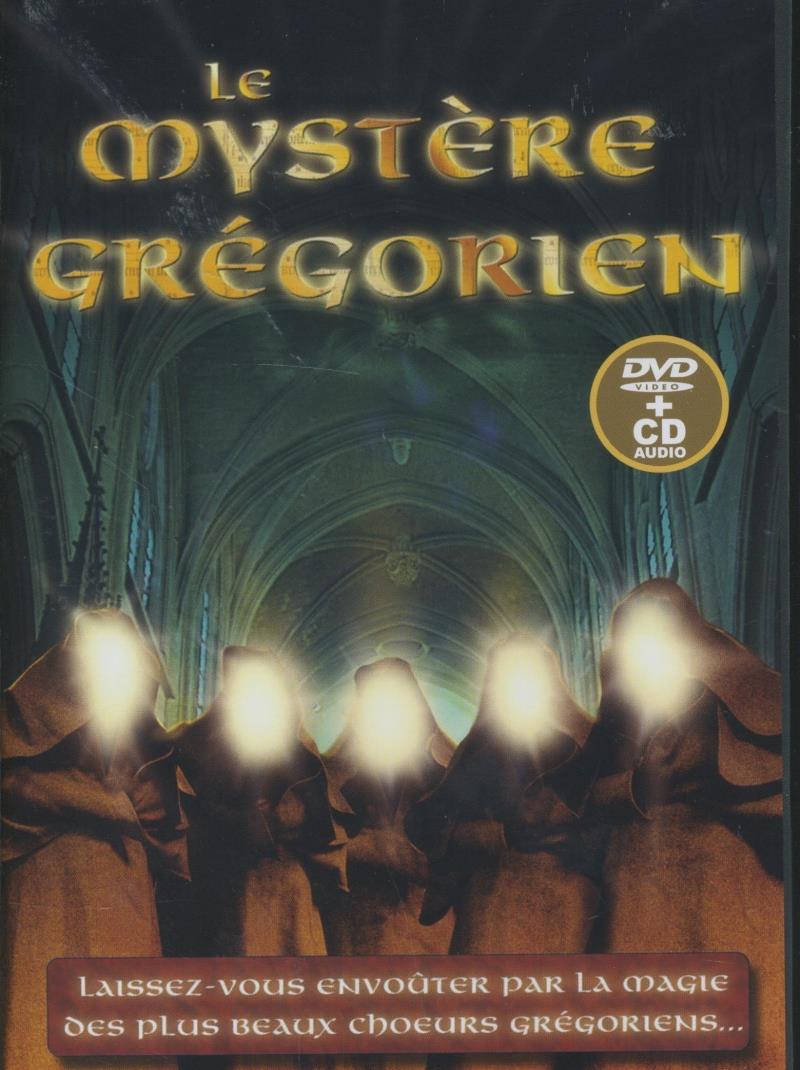Gregorian Chant / Hortus Musicus
Relaxing Chants and Beautiful Medieval Music

worldcat.org
FGL Productions / Silva Screen Records SSVE 4005
2005
C
TITLE MUSIC [1:44] [Christi Fili Dei]
Gregorian Chant
1. Kirie [2:47]
2. Christe Fili Dei [1:58]
3. Veni Creator Spiritus [3:01]
4. Victime Paschali Laudes [2:00]
5. Sanctus [1:42]
6. Agnus Dei [1:32]
7. Haec Est Causa [0:58]
8. Ego Sum [2:32]
9. Sicut Cervus [3:39]
10. Te Deum [6:47]
11. Ave Maria [2:43]
12. Pater Noster [1:15]
13. Haec Dies [4:01]
14. Alleluia [1:28]
Secular Music
1. Rex Coeli [2:01]
2. Sanctus & Benedictus [1:41]
3. Deo Confitemini [1:36]
4. Nos Qui Vivimus [1:10]
5. Sit Gloria [0:44]
6. Deus Miserere [2:41]
7. Benedicamus [1:55]
cc 112
Medieval Music
1. Gaite De La Tor [1:33]
2. La Manfredina & La Rotta Della Manfredina [3:39]
3. Saltarello 1 [3:25]
4. Agdyr Agaa [2:39]
5. Chaitarma [2:15]
6. Istampitta Isabella [5:51]
7. Saltarello 2 [4:52]
8. Presens Dies [2:19]
CB 21* supp
9. Coelum Non Animum [1:32]
CB 15
10. Vite Perdite Me Legi [2:09]
CB 31
11. O Varium Fortune Lubricum [2:04]
CB 14
12. Procurans Odium [3:53]
CB 12
END TITLE MUSIC [3:15] [Ave Maria / Pater noster]

HORTUS MUSICUS
with
GREGORIANS
Siim Valdmets,
Jaan J. Leppik,
Joosep Vahermägi,
Tõnis Kaumann,
Jaan Arder
Margo Kolar,
Riho Ridbeck,
Taniel Kirikal,
Andres Mustonen
MEDIEVAL
Imre Eenma – violone
Neeme Punder – traverse flutes
Olev Ainomäe – dulcian / tenor pommer
Valter Jurgenson – tenor bass trombone
Riho Ridbeck – percussions
Jaan Arder – singer
Tõnis Kuurme – discant pommer / shawm
Joosep Vahermägi – singer
Andres Mustonen – violin
Peeter Klaas – viola da gamba
Ivo Sillamaa – organ
SECULAR
Voices
Siim Valdmets,
Joosep Vahermägi,
Jaan Arder,
Jaan J. Leppik
Tõnis Kaumann,
Taniel Kirikal,
Margo Kolar,
Riho Ridbeck
Musicians secular
Peeter Klaas – viola da gamba
Neeme Punder – traverse flutes
Imre Eenma – viola da gamba
Andres Mustonen – orchestra director
Olev Ainomäe – dulcian / tenor pommer
Valter Jurgenson – tenor bass trombone
Tõnis Kuurme – discant pommer / shawm
Ivo Sillamaa – organ
Conductor:
Andres Mustonen
All music arranged by Andres Mustonen and published by Edition FGL
GREGORIAN CHANT
Directed by Christophe Mourthé
Produced by Thierry Wolf
Edited by Thomas Michel
Sound and Mixing Engineer: Fabrice Costello
Sound Mixed at Barouff Studios, Boulogne, France
Cameramen:
Pierre-Louis Lacombe, Christophe Mourthé, Thierry Wolf, Alex KK
Régie Génerale: Damien Lemonnier
Recorded at the Toom Kirik and the Chatariina Kirik in Tallinn, Estonia
Executive Producer for FGL PRODUCTIONS SA: Natalia Tkachenko
Authoring: Arnaud Châtelain
Product Manager: Damien Lemonnier
Sound Mastering: Jean-Pierre Chalbos at La Source, Paris
Video Mastering: Arnaud Châtelain, Thomas Michel
Official website: www.fglmusic.com
Produced by Thierry Wolf for FGL PRODUCTIONS S.A.
℗ 2004 FGL PRODUCTIONS S.A.
© 2005 FGL PRODUCTIONS S.A.
SILVA SCREEN RECORDS LTD.
sound · sterero, 5.1 surround
aspect ratio · 16:9
region · 0
running time 89 mins approx.
format · par dvd5
produced · made in england

Gregorian Chant
As
the presenter of Classic Fm's Relaxing Classics at Two, I'm inundated
with emails from people in the UK and around the world who thank me for
playing such soothing music. We all lead very stressful lives, and music
is one of the great ways of unwinding, whether we're slaving over a hot
computer, or snatching some quiet time while the kids are taking a nap.
This DVD uses the same philosophy, with music so pure that it's like
having the ultimate detox!
It was in 1972 that Horticus Musicus
gave their first concert in Estonia, making them the oldest continuously
working ensemble, specialising in early music, in Eastern Europe. It
all started when Andres Mustonen, a violin student of the then Tallinn
State Conservatory, got together with a group of musicians, who shared
his enthusiasm for Gregorian Chant, Medieval and Renaissance music.
Although they occasionally perform music from other periods,
particularly the works of the Estonian composer Arvo Part, it's Early
Music where Hortus Musicus particularly feel at home.
Mustonen
managed to found the ensemble against all the odds. They had no money
and it was the height of the Cold War, with Estonia firmly in the grip
of Soviet domination. The authorities had their own ideas as to what
music should sound like, and this group of musicians rebelled against
what they saw as state interference. Subconsciously it may be because of
this that they decided to explore the then unknown world of music from
the pre-Bach era. But the other influence must surely be Tallinn itself,
the medieval capital of Estonia, which oozes history from every pore,
particularly from its ancient churches, including the 13th century
Lutheran Toom Kirik (Dome Church) where this DVD was mainly recorded.
Whatever the reason, it obviously struck a chord with the audience
because for more than 30 years they've given concerts in the vast
territory of the former Soviet Union, America, Japan and most of Europe.
However it's in the beautiful Old Town of Tallinn, which is on the
UNESCO World Heritage list, where Hortus Musicus like performing most of
all. You can see, feel and touch history everywhere in this
overwhelmingly romantic city, with its medieval architecture, slender
church spires, narrow cobbled streets and red roofs providing the
perfect ambiance for a magical concert.
Hortus Musicus translates
as "music garden" which is a very apt description of the performances
filmed for this DVD. The overall sound is the same, but within it,
rather like a garden, there are different features. The programme is
split into three sections: Gregorian Chant, Medieval Music, and Secular
Music.
Gregorian Chant gets its name from Pope Gregory who was
inaugurated in 590 AD, and is based on the plainsong repertoire of the
early Christian church, consisting of single-line chants without
instrumental accompaniment.
Medieval Music roughly covers the
period between 1200 and 1450 and falls into two categories, the
religious and the secular. The latter ran parallel to the development of
church music, and was spearheaded by the troubadours - poet musicians
who sang of beautiful ladies and chivalry. Towards the end of this
section there are four songs from the original Carmina Burana, the 13th
century student poems found in the monastery of Benedikbeuren in
Bavaria. The lyrics talk of the fickleness of fortune, the ephemeral
nature of life, the joy of the return of spring, and the pleasures of
drinking, gluttony, gambling and lust. In the 20th century the German
composer, Carl Orff, turned these poems into what he called a "scenic
cantata" using a large orchestra, chorus and solo vocalists. But the
original manuscript contained musical settings of some of the poems, and
it's these we hear on the DVD, starting with Presens Dies and ending
with O Varium Fortune Lubricum.
Apart from their voices, Hortus
Musicus use some wonderful period instruments such as the shawm, the
precursor to the oboe, which has a loud shrill tone. The dulcian is an
early one piece bassoon, whereas the transverse flute was the term used
for the side-blown flute until about the middle of the 18th century. But
probably the most popular of the early instruments was the viola da
gamba (meaning leg-viol) which like a cello was held between the legs,
and has a particularly mournful sound.
One of the aims of Hortus
Musicus is to revive forgotten compositions, while promoting the
diversity of ancient European music. This they manage to do at a time
when Estonia is finding its own way in the world, having finally gained
independence from their Soviet masters in 1991. During the country's
occupation there was violent suppression of the Estonian church's
autonomy which led to the closure of the monasteries, making this DVD
particularly poignant. Although Gregorian Chant is steeped in the past,
this Estonian ensemble encapsulates all the optimism and hope for their
country's future.
Dick Bailey

amazon.fr
Wagram
2003
1. Kyrie |
2. Inno. Conditor |
3. Christi Fili Dei Vivi (Ps. 21) |
4. Rex Caeli |
5. Responsorio. Verbum
6. Tollite Portas |
7. Alleluia. Post Partum |
8. Ego Sum Alpha & Omega |
9. Inno. Gloria Laus |
10. Sanctus & Benedictus
11. Inno. Pange Lingua |
12. Ave Maria |
13. Deo Confitemini ~ Domino |
14. Ave Maria |
15. Deus Miserere
16. Canto Al Vangelo. Oportebat |
17. Santa Maria Amar
CSM 7 |
18. Alleluia |
19. Cunctipotens Genitor Deus |
20. Sanctus & Benedictus
21. Graduale . Ecce Quam Bonum |
22. Pater Noster |
23. Agnus Dei |
24. Veni Creator Spiritus |
25. Alleluia. Per Te Dei Genetrix
26. Benedictus Dominus |
27. Maria Assumptio ~ Huius Chori |
28. Sicut Cervus |
29. Benedicamus Domino
cc 112 |
30. Final Bells







DVD + CD
fglmusic.com
FGL VIA 070221
2007
DVD contents like that of Gregorian Chant SSVE 4005
CD
1. Pater noster [1:15]
2. Sanctus [1:41]
3. Victime paschali laudes [1:58]
4. Benedicamus [1:31]
cc 112
5. Ego sum alpha et omega [2:59]
6. Cunctipotens genitor Deus [1:47]
7. Qui amat animam suam [1:54]
8. L'ontellecto divino [2:49]
9. Orgel choral [2:41]
10. Agnus Dei [1:32]
11. Ave Maria [1:35]
12. Miserere [2:07]
13. Santa Maria amar [9:35]
CSM 7













